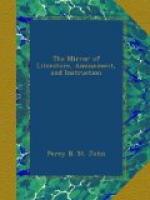Some of the migratory birds approach much nearer to London than is generally imagined. The Cuckoo and Wood-pigeon are heard occasionally in Kensington-gardens. The Nightingale approaches also much nearer to London than has been commonly supposed. I heard it in melodious song at seven o’clock in the morning, in the wood near Hornsey-wood House, May 10, 1826, which is, I believe, the nearest approach to St. Paul’s it has been for some time known to make. It is also often heard at Hackney and Mile-end. I have also heard it regularly for some years past in a garden near the turnpike-gate on the road leading from London to Greenwich, a short distance from the third mile stone from London-Bridge. This charming bird may be also heard, during the season, in Greenwich Park, particularly in the gardens adjoining Montagu-house; but never, I believe, on its lofty trees. The Nightingale prefers copses and bushes to trees; the Cuckoo, on the contrary, prefers trees, and of these the elm, from which it most probably obtains its food. The Nightingale is also common at Lee and Lewisham, Forest-hill, Sydenham, and Penge-wood; in all these places, except Hackney and Mile-end, I have myself often heard it, and in the day-time. Those who are partial to the singing of birds generally, will find the morning, from four to nine o’clock, the most favourable time for hearing them——Jennings’s Ornithologia.
* * * * *
MOCK SUNS.
In the centre of the heavens above us, the sun began to break through the mist, forming a clear space, which, as it grew wider by the gradual retreat of the mist and clouds, was enclosed or surrounded by a complete circle of hazy light, much brighter than the general aspect of the atmosphere, but not so brilliant as the sun itself. This circle was about half as broad as the apparent size of the sun, through which it seemed to pass, while on each side of the sun, at about the distance of a sixth of the circumference of the ring, which likewise traversed them, were situated two mock suns, resembling the real sun in everything but brightness, and on the opposite side of the circle two other mock suns were placed, distant from each other about a third of the circuit of the band of light, forming altogether five suns, one real and four fictitious luminaries, through which a broad hoop of subdued light ran round an area of slightly hazy blue sky. The centre of this area was occupied by a small segment of a rainbow, the concave side of which was turned from the true sun, while on its convex edge, in contact with it at its most prominent part, was stretched a broad straight band of prismatic colours, similar to the rainbow in all but curvature. Across the space, within the circle of light, there was a broad stream of dusky cloud, formed of three distinct streaks, and reaching from one of the most distant mock suns to another opposite to it, in the shape of a low arch; but in a little while one extremity of this bar moved away from its original position, while the other end remained stationary, leading me to suppose that it was merely an accidental piece of cloud.




